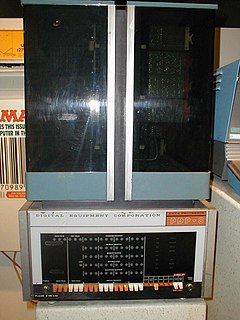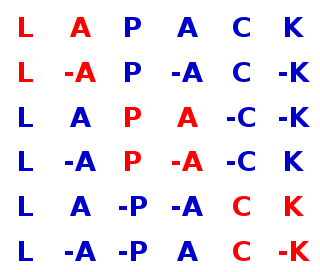
The PDP-8 is a 12-bit minicomputer that was produced by Digital Equipment Corporation (DEC). It was the first commercially successful minicomputer, with over 50,000 units being sold over the model's lifetime. Its basic design follows the pioneering LINC but has a smaller instruction set, which is an expanded version of the PDP-5 instruction set. Similar machines from DEC are the PDP-12 which is a modernized version of the PDP-8 and LINC concepts, and the PDP-14 industrial controller system.
In computer science, threaded code is a programming technique where the code has a form that essentially consists entirely of calls to subroutines. It is often used in compilers, which may generate code in that form or be implemented in that form themselves. The code may be processed by an interpreter or it may simply be a sequence of machine code call instructions.
Programmed Instruction, Learning, or Teaching (PILOT) is a simple high-level programming language developed in the 1960s. Like its younger sibling LOGO, it was an early foray into the technology of computer-assisted instruction.
In computing, a computer program or subroutine is called reentrant if multiple invocations can safely run concurrently. The concept applies even on a single processor system, where a reentrant procedure can be interrupted in the middle of its execution and then safely be called again ("re-entered") before its previous invocations complete execution. The interruption could be caused by an internal action such as a jump or call, or by an external action such as an interrupt or signal. The previous invocations may resume correct execution before the reentered invocation completes, unlike recursion, where the previous invocations may only resume correct execution once the reentered invocation completes.
In computer science, imperative programming is a programming paradigm that uses statements that change a program's state. In much the same way that the imperative mood in natural languages expresses commands, an imperative program consists of commands for the computer to perform. Imperative programming focuses on describing how a program operates.
Coroutines are computer program components that generalize subroutines for non-preemptive multitasking, by allowing execution to be suspended and resumed. Coroutines are well-suited for implementing familiar program components such as cooperative tasks, exceptions, event loops, iterators, infinite lists and pipes.
In computer programming, a parameter or a formal argument, is a special kind of variable, used in a subroutine to refer to one of the pieces of data provided as input to the subroutine. These pieces of data are the values of the arguments with which the subroutine is going to be called/invoked. An ordered list of parameters is usually included in the definition of a subroutine, so that, each time the subroutine is called, its arguments for that call are evaluated, and the resulting values can be assigned to the corresponding parameters.
A link register is a special-purpose register which holds the address to return to when a function call completes. This is more efficient than the more traditional scheme of storing return addressed on a call stack, sometimes called a machine stack. The link register does not require the writes and reads of the memory containing the stack which can save a considerable percentage of execution time with repeated calls of small subroutines.
In computer programming, a thunk is a subroutine used to inject an additional calculation into another subroutine. Thunks are primarily used to delay a calculation until its result is needed, or to insert operations at the beginning or end of the other subroutine. They have a variety of other applications in compiler code generation and modular programming.
In computer programming, a return statement causes execution to leave the current subroutine and resume at the point in the code immediately after the instruction which called the subroutine, known as its return address. The return address is saved by the calling routine, today usually on the process's call stack or in a register. Return statements in many languages allow a function to specify a return value to be passed back to the code that called the function.
In computer programming, a statement is a syntactic unit of an imperative programming language that expresses some action to be carried out. A program written in such a language is formed by a sequence of one or more statements. A statement may have internal components.

LAPACK is a standard software library for numerical linear algebra. It provides routines for solving systems of linear equations and linear least squares, eigenvalue problems, and singular value decomposition. It also includes routines to implement the associated matrix factorizations such as LU, QR, Cholesky and Schur decomposition. LAPACK was originally written in FORTRAN 77, but moved to Fortran 90 in version 3.2 (2008). The routines handle both real and complex matrices in both single and double precision.
In computer science, a tail call is a subroutine call performed as the final action of a procedure. If a tail call might lead to the same subroutine being called again later in the call chain, the subroutine is said to be tail-recursive, which is a special case of recursion. Tail recursion is particularly useful, and often easy to handle in implementations.
In computer science, a call stack is a stack data structure that stores information about the active subroutines of a computer program. This kind of stack is also known as an execution stack, program stack, control stack, run-time stack, or machine stack, and is often shortened to just "the stack". Although maintenance of the call stack is important for the proper functioning of most software, the details are normally hidden and automatic in high-level programming languages. Many computer instruction sets provide special instructions for manipulating stacks.
In computer science, a calling convention is an implementation-level (low-level) scheme for how subroutines receive parameters from their caller and how they return a result. Differences in various implementations include where parameters, return values, return addresses and scope links are placed, and how the tasks of preparing for a function call and restoring the environment afterward are divided between the caller and the callee.
RS08 is a family of 8-bit microcontrollers by NXP Semiconductors. Originally released by Freescale in 2006, the RS08 architecture is a reduced-resource version of the Freescale MC68HCS08 central processing unit (CPU), a member of the 6800 microprocessor family. It has been implemented in several microcontroller devices for embedded systems.
A wrapper function is a subroutine in a software library or a computer program whose main purpose is to call a second subroutine or a system call with little or no additional computation. Wrapper functions are used to make writing computer programs easier by abstracting away the details of a subroutine's underlying implementation.

The FX-702P is a Pocket Computer, manufactured by Casio from 1981 to 1984.
This article attempts to set out the various similarities and differences between the various programming paradigms as a summary in both graphical and tabular format with links to the separate discussions concerning these similarities and differences in extant Wikipedia articles.
In computer programming, a subroutine is a sequence of program instructions that performs a specific task, packaged as a unit. This unit can then be used in programs wherever that particular task should be performed.


